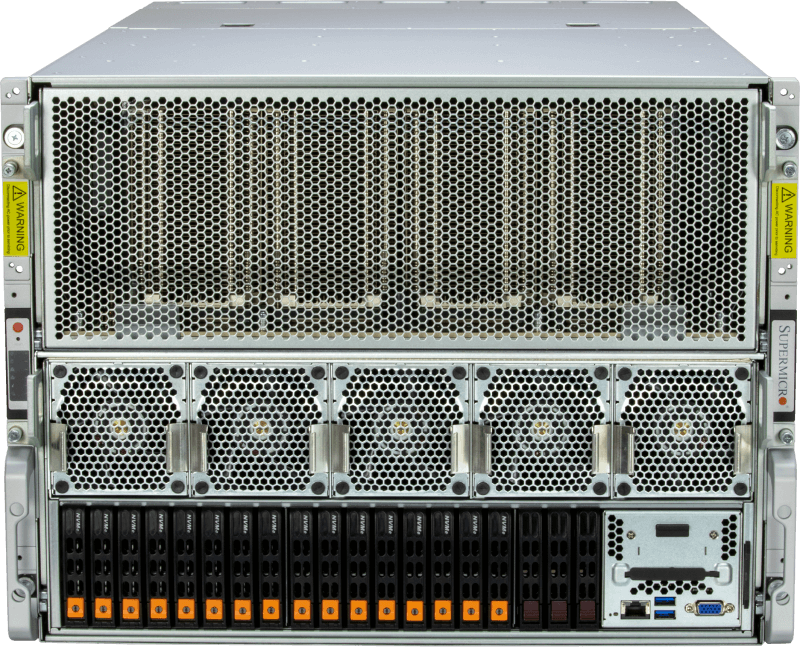AI-Powered Telecom for Leading Strategic Growth and Innovation
The telecommunications industry is at a critical juncture, with telcos uniquely positioned to drive digital transformation and economic growth. By building robust AI infrastructures, telcos can offer advanced AI services to various sectors, from healthcare to finance, creating new revenue streams and fostering cross-industry partnerships.
Supermicro, in collaboration with NVIDIA, delivers AI-powered infrastructure tailored for telcos, enhancing operational efficiency, network management, and customer experiences. Our solutions enable telcos to leverage AI for strategic growth, positioning them as leaders in the evolving digital economy.

“The global AI in telecommunication market is expected to grow at a 41.4% CAGR from 2024 to 2033, with applications across network security, optimization, customer analytics, virtual assistance and self-diagnostics”
“90% of telco executives report that their organizations are currently engaged with AI from the experimentation stage to full-scale deployment”
AI Factories for Sovereign AI Infrastructure
Elevating Data Centers with Cutting-Edge AI Capabilities
- Data Centers Optimized for AI Training and Inferencing
- Secure Infrastructure
- AI Models Optimized for National and Local Culture
- Expanded Data Center Capabilities
AI factories enable telcos to enhance their data centers with specialized AI infrastructure, supporting national AI initiatives and providing secure, high-performance solutions for various sectors.
“‘Cooperation with global leading companies in the AI data center sector will be the cornerstone for SK Telecom to emerge as a global AI company,’ SK Telecom CEO Ryu Young-sang said. ‘Through cooperation with Supermicro and Lambda, SK Telecom’s AI data center business is expected to achieve meaningful results within this year.’”
“‘I am a firm believer that every country ought to have some sovereign capability on artificial intelligence, including large language models for AI,’ said IBM chairman and CEO Arvind Krishna. ‘The government needs to support setting up national AI computing centers and common data sets for specific use cases5.’”
5G Monetization with Edge AI and 6G Research
Maximizing 5G Potential and Driving 6G Innovation
- 5G Edge Monetization
- AI-Driven 6G R&D
- Revenue Opportunities
- Edge Computing
Telcos can capitalize on 5G monetization and accelerate 6G innovation by integrating AI, creating new revenue streams and enhancing connectivity with advanced edge computing and immersive experiences.
“According to GSMA, the network accounts for 90% of energy use for an operator on average and the RAN represents more than 80% of this. 97% of executives in the survey believe that embracing higher levels of autonomous networks will optimize energy usage, concurrently reducing carbon emissions within their organizations”
“‘When we are designing the 6G network, we’re going to use AI technology in designing the air interface and also in managing the 6G network,’ says Qin. ‘The 6G network will self-train, self-learn, and it will actually grow to become more and more powerful6.’”
Reimagining Contact Centers
Enhancing Customer Experiences with AI
- Automated Inquiry Handling
- Enhanced Representative Support
- Seamless Omnichannel Experience
- B2B Service Expansion
AI-powered contact centers transform customer interactions, streamline operations, and offer advanced support, making them a valuable asset for both internal use and B2B offerings.
“Communication Service Providers are placing strong emphasis on using generative AI to enhance customer-centricity with chatbots the most widely adopted use case, with 63% of respondents who selected this use case indicating it was already in production”
62% of customers would rather use a customer service chatbot than wait for a human representative1.
Streamlined Network Operations
Optimizing Efficiency with AI-Driven Automation
- Automated Maintenance
- Self-Optimizing Networks
- 5G Enhancement
- Predictive Analytics
AI-driven solutions streamline network operations, enhance efficiency, and improve service quality by automating maintenance and optimizing resource management.
“Improving efficiency and productivity by using generative AI is by far the highest value driver. 41% of Communication Service Providers see generative AI as assisting employees in producing quicker and higher quality output”
In 2023, 37% of respondents were investing in network predictive maintenance and 34% were investing in network planning and operations (including RAN)2.
By 2028, 61% of telco aspire to at least achieve a conditional autonomous network that can sense real-time environmental changes and, in certain network domains, optimize and adjust its operation to the external environment to enable intent-based closed-loop management3.
Predictive Analytics for Business Insights
Transforming Business Intelligence through AI
- Advanced Customer Insights
- Operational Efficiency
- B2B Services Expansion
- Customized Solutions
AI-powered predictive analytics enable telcos to gain deeper customer insights, enhance operational efficiency, and extend valuable services to B2B clients, driving business success and innovation.
“42% of telcos respondents are piloting or have a partial/full scale implementation of an autonomous network to understand subscriber churn/behavior and take corrective action to retain customers”
“I have seen how AI can help increase productivity in customer care operations and create new services such as personalized customer experiences, targeted marketing campaigns and automated customer service chatbots4.”
How AI Factories Create New Opportunities for Telcos
Telecom operators are perfectly positioned to expand their data centers with accelerated computing infrastructure to support generative AI models and manufacture intelligence. This new class of data centers, known as AI factories, enhances generative AI training and inference for local governments, enterprises, and startups.
Discover how a full-stack generative AI platform, powered by Supermicro and NVIDIA, enable telecom companies to unlock new revenue opportunities in a dynamic market.
Join our webinar with industry experts from Supermicro and NVIDIA as we explore:
- What is an AI factory?
- What is the opportunity for telecom companies with AI factories?
- What are examples of telecom companies that are becoming AI cloud providers?
- How do Supermicro and NVIDIA support sovereign AI factory providers?















